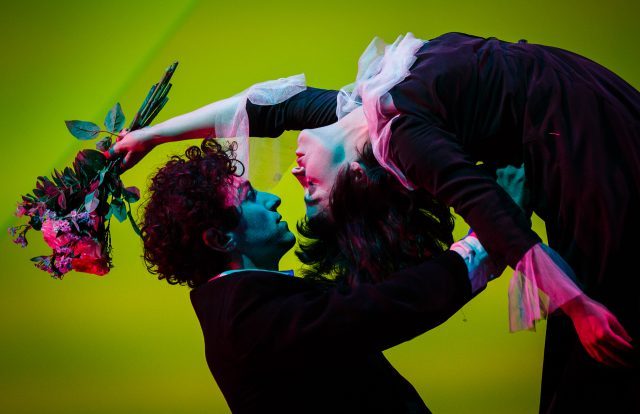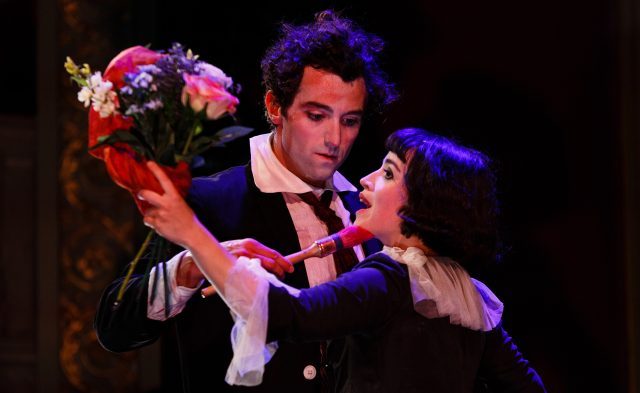
Marc Antolin and Audrey Brisson shine as Marc and Bella Chagall in The Flying Lovers of Vitebsk (photo © Steve Tanner)
THE FLYING LOVERS OF VITEBSK
December 11-18, $20 three-day rental
nyuskirball.org/chagall
Standing in front of a Marc Chagall painting can transport you to another world, a fantastical realm of lavish colors where humans and animals float through the air and fiddlers perform on rooftops. The Bristol Old Vic, Kneehigh, and Wise Children have captured the essence of the lush canvases as well as the artist himself in the gorgeously rendered revival of Daniel Jamieson’s The Flying Lovers of Vitebsk, streaming via NYU Skirball through December 18.
Filmed with three cameras and no audience at the UK’s Bristol Old Vic Theatre, the ninety-minute show is one of the best productions of the pandemic lockdown, an enchanting, bittersweet love story that will make your heart soar. Essentially a memory play, The Flying Lovers of Vitebsk recounts the tender romance between Chagall (Marc Antolin), born Moishe Zakharovich Shagal in 1887 in what is now Belarus, and Bella Samoylovna Rosenfeld (Audrey Brisson), born eight years later in the shtetl of Vitebsk to a well-off family that owned three jewelry stores. They fall madly, passionately in love when they meet in 1909; “I want to waste the rest of my life with you,” she tells him. Over the course of their life together, they experience more highs than lows as they deal with his success as a painter in Western Europe but struggles at home amid WWI, the Russian Revolution, and the rise of fascism and anti-Semitism.

The Flying Lovers of Vitebsk brings to vivid life the memorable relationship between Marc and Bella Chagall (photo © Steve Tanner)
Director Emma Rice’s staging is magnificent, as are the performances. Antolin (The Trial, Taken at Midnight) and Brisson (Secret Cinema, The Wild Bride) are engaging as the sweethearts, both wearing white greasepaint as if primed canvases ready for action; when he paints her, he gently touches her face with a brush. They occasionally break into song, in English, French, and Yiddish, accompanied by composer and pianist Ian Ross and cellist James Gow, who also appear as minor characters throughout. There are also several scenes of lovely contemporary dance, choreographed by Rice and Etta Murfitt, that reference such Chagall works as 1914’s Blue Lovers, 1915’s Green Lovers and Birthday (when it premiered in 1992, the play was titled Birthday), 1916’s Lovers in Pink, 1917’s Study for Double Portrait with Wine Glass, and the much later Bouquet with Flying Lovers (ca 1934-47).
The small, intimate set by Sophia Clist, who also designed the costumes, places the actors in between empty wooden picture planes in the front and a wall of twisted canvas in the back, with drawings of flowers on the floor; it as if the Chagalls are a painting come to life. The playful nature of Marc’s painting is echoed in Rice’s use of props, including a red balloon as Bella’s mother, a portrait of their rabbi that Brisson sits behind and puts her arms through, and animal objects from the paintings that become Salvador Dalí-like chapeaux. Cinematographer Steve Tanner occasionally cuts to a long shot of the mostly empty theater, reminding us where we are and what we’re experiencing together, but he quickly puts us right back onstage with Marc and Bella and their impassioned love. Malcolm Rippeth’s lighting and Simon Baker’s sound are excellently coordinated for online viewing.
Early on, Marc tells his biographer and son-in-law, Franz Meyer, “When some things are gone, you thirst for their details in such a heartbreaking way. You feel an agony of need to remember.” The Bristol Old Vic’s The Flying Lovers of Vitebsk is an exhilarating reminder of the power of live theater, the power of art, and the power of true love. Don’t miss it.